The Broken Ear (French:
L'Oreille cassée)
Original publication dates: December 1935 – February 1937
First collected edition: 1937 (partially redrawn colour edition published in 1943)
Author: Hergé
Tintin visits: Belgium (Brussels), France (Le Havre), San Theodoros (Los Dopicos), Nuevo Rico (Sanfacion, Arumbaya village)
Overall rating:





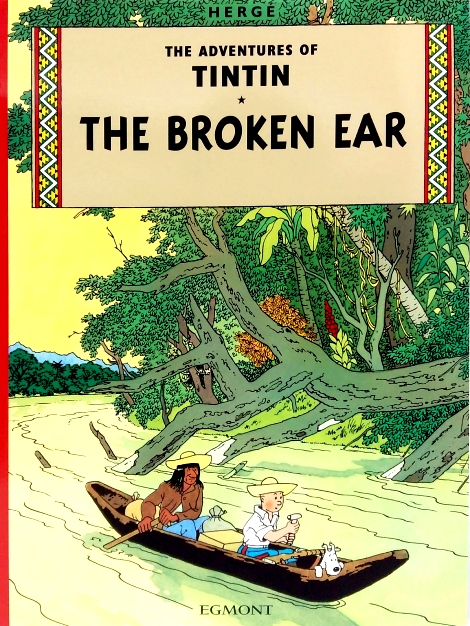 Plot summary available here
Plot summary available here.
Publisher's synopsis:
An Indian fetish is stolen from the Museum of Ethnography. Why? Much to Snowy's disapproval Tintin is soon up to his neck in one of his strangest and most exciting investigations, following a curious trail to South America, revolution, and General Alcazar.Comments:
The Broken Ear is a much more lightweight and – dare I say it – throwaway story than its predecessor,
The Blue Lotus. It also has a few problems with its plotting too, but that's not to say that it isn't a highly enjoyable adventure in its own right. For one thing, there's more comedy in it than there was in the last Tintin story and the plot develops in a highly gripping fashion, with the mystery of the missing Arumbaya fetish and the murder of Dr. Balthazar unfolding very much like a detective thriller. The coveted Arumbaya fetish itself was actually based on a real pre-Columbian idol that Hergé saw in the Royal Museum of Art and History in Brussels...
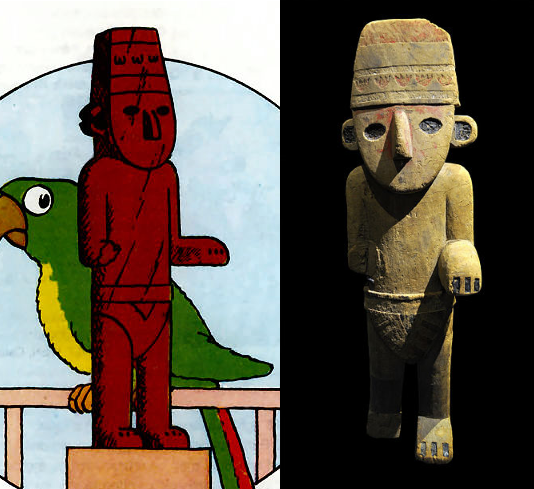
Interestingly, following the disappearance of the fetish, we get a rare glimpse of Tintin's home life at 26 Labrador Road. His apartment is sparsely decorated, with souvenirs of his travels clearly visible (such as a vase and wall hangings from his recent trip to China), and the boy reporter begins his day by doing some exercises (in some rather splendid pyjamas), before taking a bath...
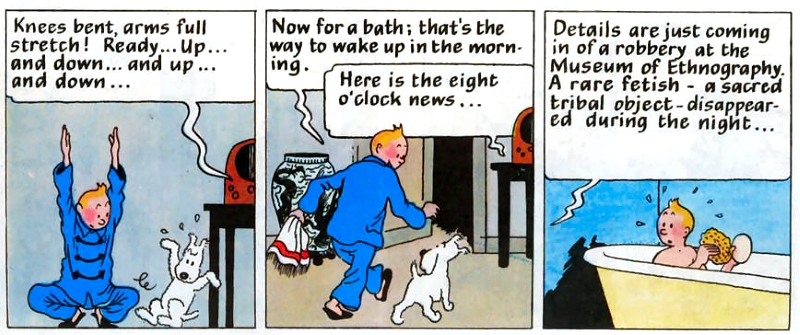
Having completed his morning ablutions, the youngster dashes out to the Museum of Ethnography to investigate the theft of the Arumbaya idol with notebook in hand, which represents a rare last appearance of Tintin the journalist in the series.
The Broken Ear rolls along in a pretty brisk manner, with equal amounts of fun and intrigue, but the plot seems less focused and more meandering than
The Blue Lotus; one minute Tintin is looking for Balthazar's parrot, the next he's on board a ship bound for South America, then suddenly he's a hero of the San Theodoros revolution, and, before you know it, he's in the rainforest with the Arumbaya. Don't get me wrong, I don't mind that the adventure and its locales change quickly, but there's something about the plotting here that just feels a bit haphazard.
Something I do want to note is that I feel as if there are a couple of prototypes for Professor Calculus, who we shall meet later in
Red Rackham's Treasure, in this book. The absent-minded professor that we briefly see on page 6 is one of them and the museum's conservator is another. Incidentally, something that I only noticed on this read through is that, when we first see him, the museum conservator has a spoon tucked behind his ear and is using a pen to stir his coffee...

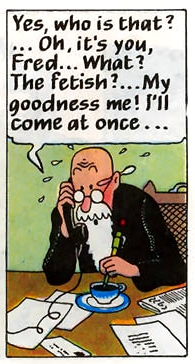
Once Tintin reaches San Theodoros, he quickly gets into trouble with the military and again finds himself in prison and then in front of a firing squad, just as he did in
Cigars of the Pharaoh. Actually, the entire "firing squad" scene can be seen as Hergé's wry commentary on the nature of political allegiances, with the army troops seamlessly and without hesitation switching sides from being supporters of General Tapioca to supporters of General Alcazar and then back to supporting Tapioca again...
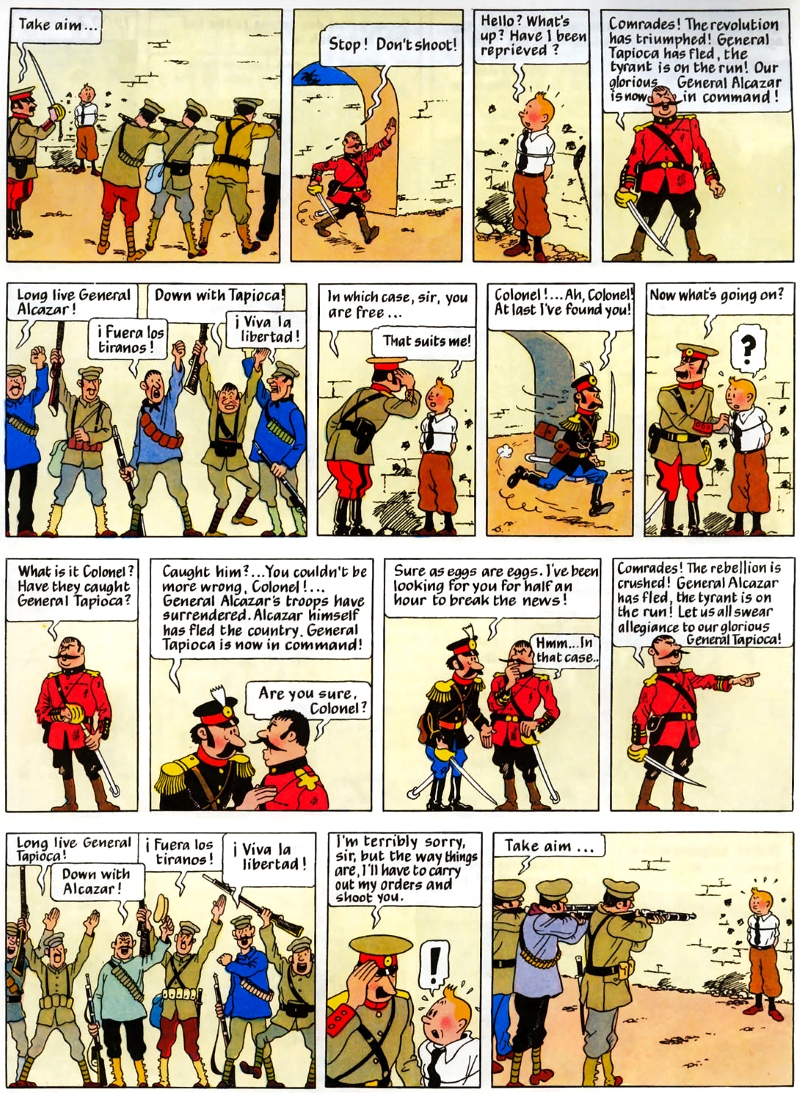
This scene can also be seen as Hergé's sarcastic take on the revolutionary fever that gripped various banana republics in South America during the 1930s.
Incidentally, a page later, we see Tintin getting drunk, which is definitely a first for the series!

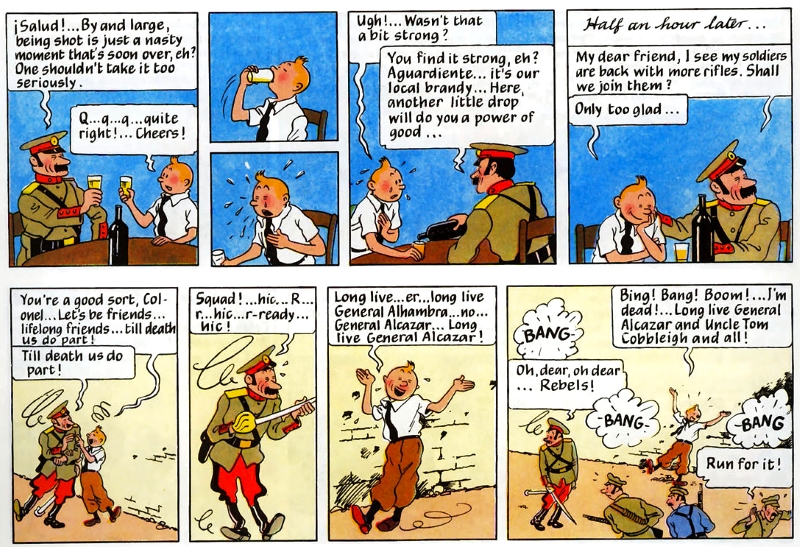
There's more political satire from Hergé a little later on, during the scenes between pages 31 and 34, when the author uses the none too subtly titled R.W. Trickler of General American Oil, and Basil Bazarov of Korrupt Arms GMBH to highlight the duplicity and moral bankruptcy of the oil and arms industries. As for the fictional countries of San Theodoros and Nuevo Rico, Wikipedia tells me that they were based on Bolivia and Paraguay, and that the Gran Chapo War, which is depicted in the book, had a real world parallel in the Gran Chaco War, which was fought between Bolivian and Paraguayan forces from 1932 until 1935 over lucrative oil fields. This kind of condemnation of war, capitalism and imperialism are becoming recurring themes in the Tintin series.
The Thom(p)son Twins make a brief appearance in
The Broken Ear, but their part in this adventure is minimal. The book also introduces us to the tinpot dictator and friend of Tintin, General Alcazar. Though he's not one of my favourite characters from the series, he is a pretty fun, larger than life character and we will see him again in
The Seven Crystal Balls,
The Red Sea Sharks and
Tintin and the Picaros. As for his rival for the rule of San Theodoros, General Tapioca (I love that he's named after one of my favourite puddings!), he's mentioned but doesn't actually appear in this book at all, and we won't get to see him until
Tintin and the Picaros, the penultimate book in the series.
After leaving Los Dopicos, the capital of San Theodoros, Tintin becomes involved in a tremendously exciting high-speed car chase, during which Hergé has the reporter driving across railway tracks, barely dodging a speeding train. From there, the car chase moves to a perilous mountain road, with the art conveying the speed and danger of the scene in a wonderfully exciting way...

Snowy is his usual cynical self throughout the early part of this adventure, although he doesn't seem to "talk" very much during the latter half of the book. The faithful terrier's tail sure does take a beating in this story though!
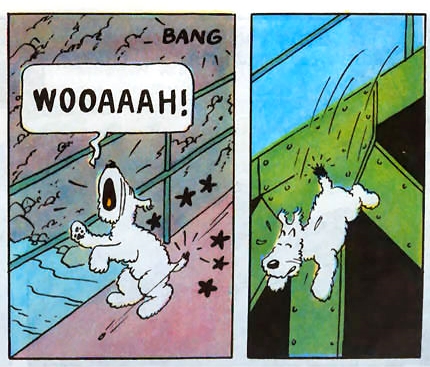
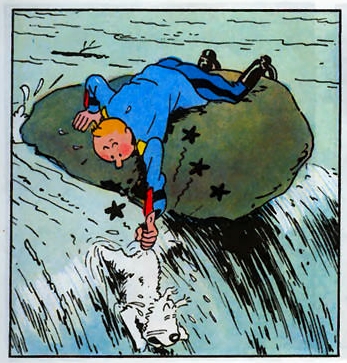
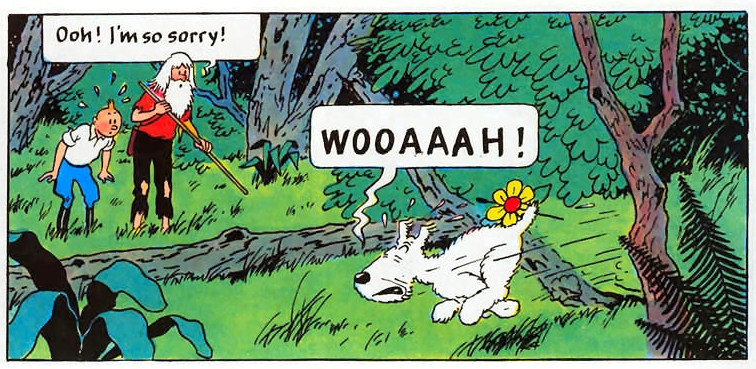
Once Tintin has escaped his San Theodoros pursuers and journeyed across the boarder into Nuevo Rico, he encounters the missing British explorer, Ridgewell, who is very much in the white-haired and raggedy-bearded "Ben Gunn" mould of westerners who are lost or marooned in remote, unexplored places. It is Ridgewell who takes Tintin to meet the Arumbaya tribe in the Nuevo Rican rainforest and here, Hergé – or, more likely, his translators Michael Turner and Leslie Lonsdale-Cooper – have a few laughs with the Arumbaya's dialogue, which seems at first to be utter gibberish, but on closer inspection turns out to be a hilarious and barely-discernible Cockney dialect. I know it's childish, but reading these Cockney-flavoured dialogue balloons always has me in fits.
Here are a couple of examples of this dialect, with some handy dandy translations by yours truly (I'm fluent in Arumbaya, dontcha know)...

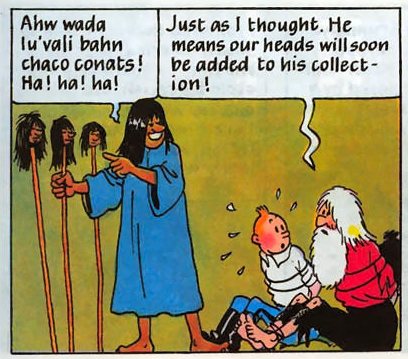 Translation: "Ah, what a lovely bunch of coconuts!"
Translation: "Ah, what a lovely bunch of coconuts!" (the song "I've Got a Lovely Bunch of Coconuts' is an old music hall novelty tune, celebrating the coconut shy at fairgrounds).
A bit later on, we meet the Arumbaya chief, Avakuki (as in, "have a cookie")...

 Translation:
Translation:Avakuki:
"How are yer? 'tis good ta meet ya, matey."Ridgewell:
"Now, look. D'yer remember the brown idol? Tintin's lookin' for it. Can ya help 'im?"Avakuki:
"The brown idol? Oi oi! It's like I told yer. The tribe give the brown idol to Walker. He was a nice guy. But his fella took our precious jewel. And after Arumbayas catch him I'll 'ave his guts for garters. No messin'!The Broken Ear might well be the funniest Tintin book in the series so far, but it also has its shortcomings. For one thing, the art in the commonly available 1943 version looks and feels a little more rushed than the exquisite drawing found in
The Blue Lotus. Some of the backgrounds are rather simplistic and lacking in detail too, and the usual attention to detail and accuracy is missing on occasion, with Hergé's version of Piranha fish being uncharacteristically inaccurate. The artist also draws the bunch of bananas that falls onto the villain Pablo as having been growing the wrong way up...
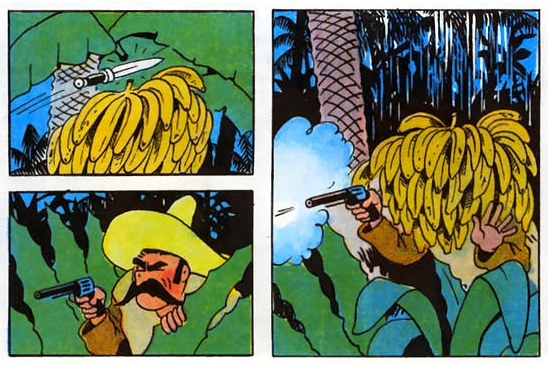
While we're on the subject of Pablo, his conversion from villain to Tintin's faithful friend, just because the young reporter spared his life, seems a bit unbelievable to me.
The Broken Ear ends with a frustrating, but oh-so-readable final chase for the fetish, which necessitates Tintin taking a ship bound for America. On board, he and the villains Alonso and Ramón desperately struggle for the diamond that we have now learned is hidden within the fetish. Hergé gives us a rather heavy-handed, moralising ending here, with the two criminals drowning after pursuing the diamond into the sea, followed by a weird, surreal scene, in which Alonso and Ramón are both carted off to hell by pitchfork wielding devils...

Overall, I feel as if
The Broken Ear is a somewhat underrated Tintin adventure, since it is definitely a lot of fun. However, it's a bit of a come down after the brilliance of
The Blue Lotus. For one thing, as I've noted, the art is really not Hergé's best, and the lack of a focused plot is another problem; the adventure begins like a mystery or detective adventure, but as it progresses, it changes into more of a political satire. It also becomes kinda hard to keep track of the criminal's motives and exactly who has done what as you read.
In addition, there are some hard to ignore plot holes present, which is very uncommon for The Adventures of Tintin. For one thing, why would Rodrigo Tortilla steal the idol from the museum and then replace it later? That's simply asking for trouble and, besides, why wouldn't he just replace it there and then, at the same time as he stole the original? I also have a hard time believing that among all the learned experts at the Museum of Ethnography, only Tintin would notice the fetish's rather obviously fixed ear.
A far more niggling problem, however, is that when Tortilla is bludgeoned to death in his cabin on page 16, Tintin could've very easily prevented it. Tintin had already overheard Alonso and Ramón planning to murder Tortilla, while he was eavesdropping on them, disguised as a waiter (wearing blackface!

). But Tintin seems to just callously allow Tortilla to be murdered, so that he can then apprehend the criminals. That doesn't sit well with me at all.
Still, in spite its shortcomings,
The Broken Ear is an engaging read. However, it's often overlooked by fans of the series, coming, as it does, on the heels of the superior
The Blue Lotus and immediately before the equally fantastic
The Black Island.